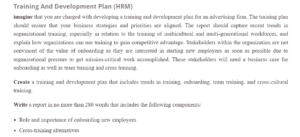Training and Development Plan Creation
Create a training and development plan that includes trends in training, onboarding, team training, and cross-cultural training.
Training is defined as the process through which employees acquire new skills and knowledge that are important for the completion of their roles in the workplace. Training is a tool that prepares employees for their job descriptions and increases their confidence, and morale (Maurer, 2021). However, training is insufficient, especially at the onboarding stage for new employees.
Role and importance of onboarding new employees
Onboarding is the process that allows new employees to be initiated into the environment. The onboarding process determines the employee’s rate or likelihood of departure from an organization. Besides ensuring that employees are familiarized with new hires, the HR department is responsible for making the new employees feel wanted and appreciated at the workplace. The program of onboarding does not need to be complicated. The company can assign a go-to person for each new hire. The go-to person will play a role in ensuring that the new employee is well-absorbed into the company’s culture, norms, and work procedures. This process creates a seamless absorption of new hires as they settle into their positions and ensures their comfort and enjoyment at the new workplace (Maurer, 2021).
Cross-training alternatives
Employers, at times, are compelled to prepare employees to perform multiple jobs. Cross-training is a suitable alternative for developing such competence. Cross-training allows employees to step in for their colleagues when unpredictable situations arise. As an informal training method, cross-training can be done through coaching, mentorship, or shadowing. The best method is chosen to suit the position. Besides keeping other employees prepared, cross-training expands their knowledge and could be useful for career development. It ensures that a learning culture is created and nurtured. Employees learn new perspectives that are beneficial to each position’s roles. Overall, it supports the productivity and efficiency of an entity (Woodward, 2009).
References
Maurer, R. (2021). New Employee Onboarding Guide. Retrieved from https://www.shrm.org/resourcesandtools/hr-topics/talent-acquisition/pages/new-employee-onboarding-guide.aspx
Woodward, N. H. (2009). Experts: Cross-Train Now for Business Continuity. Retrieved from https://www.shrm.org/hr-today/news/hr-news/pages/crosstrainnow.aspx
ORDER A PLAGIARISM-FREE PAPER HERE
We’ll write everything from scratch
Question
Training And Development Plan (HRM)
imagine that you are charged with developing a training and development plan for an advertising firm. The training plan should ensure that your business strategies and priorities are aligned. The report should capture recent trends in organizational training, especially in relation to the training of multicultural and multi-generational workforces, and explain how organizations can use training to gain competitive advantage. Stakeholders within the organization are not convinced of the value of onboarding as they are interested in starting new employees as soon as possible due to organizational pressure to get mission-critical work accomplished. These stakeholders will need a business case for onboarding as well as team training and cross training.

Training and Development Plan Creation
Create a training and development plan that includes trends in training, onboarding, team training, and cross-cultural training.
Write a report in no more than 280 words that includes the following components:
- Role and importance of onboarding new employees
- Cross-training alternatives

